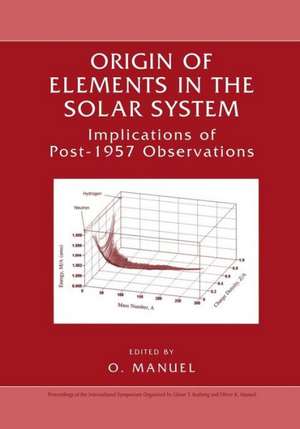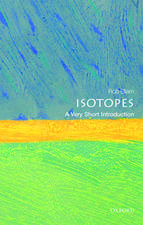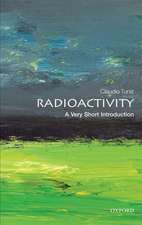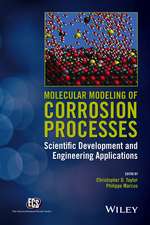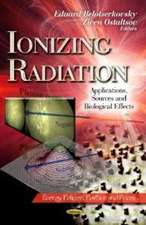Origin of Elements in the Solar System: Implications of Post-1957 Observations
Editat de Oliver K. Manuelen Limba Engleză Paperback – 18 iul 2013
| Toate formatele și edițiile | Preț | Express |
|---|---|---|
| Paperback (1) | 969.93 lei 43-57 zile | |
| Springer Us – 18 iul 2013 | 969.93 lei 43-57 zile | |
| Hardback (1) | 851.35 lei 38-44 zile | |
| Springer Us – 31 mai 2001 | 851.35 lei 38-44 zile |
Preț: 969.93 lei
Preț vechi: 1182.84 lei
-18% Nou
Puncte Express: 1455
Preț estimativ în valută:
185.65€ • 201.73$ • 156.05£
185.65€ • 201.73$ • 156.05£
Carte tipărită la comandă
Livrare economică 21 aprilie-05 mai
Preluare comenzi: 021 569.72.76
Specificații
ISBN-13: 9781475773156
ISBN-10: 1475773153
Pagini: 672
Ilustrații: XXI, 646 p. 46 illus., 2 illus. in color.
Dimensiuni: 178 x 254 x 35 mm
Greutate: 1.15 kg
Ediția:2002
Editura: Springer Us
Colecția Springer
Locul publicării:New York, NY, United States
ISBN-10: 1475773153
Pagini: 672
Ilustrații: XXI, 646 p. 46 illus., 2 illus. in color.
Dimensiuni: 178 x 254 x 35 mm
Greutate: 1.15 kg
Ediția:2002
Editura: Springer Us
Colecția Springer
Locul publicării:New York, NY, United States
Public țintă
ResearchCuprins
Glenn Seaborg and the Quest for Superheavy Elements.- Ghiorso Remembers Seaborg.- Superheavy Elements at Berkeley: The Culmination of Seaborg’s Career.- The Discovery of Superheavy Elements 107–112 and of the Deformed Shell at N = 162.- The Nuclear Reactions That Made Our Elements.- The Decay of 19N.- Measuring the Astrophysics Rate of the 21Na(p,?)22Mg Reaction.- Production and ?-Decay Half-Lives of Very N-Rich Nuclei.- The Role of the N = 28 and N = 40 Closed Shells in the Production of the Neutron-Rich Ca-Ti-Cr-Fe-Ni Elements in the Universe.- Experimental Studies Related to s-process Abundances.- Neutron Capture Cross Section Measurements for the Analysis of the s-process.- About the Reliability of Extrapolation of Nuclear Structure Data for r-process Calculations.- The Astrophysical r-process.- Nuclear Aspects of Stellar and Explosive Nucleosynthesis.- Proton Captures in the Atmosphere of Accreting Neutron Stars.- A Cosmological View of Nucleosynthesis.- The Origin of the Elements.- Chemical Evolution Tomorrow.- LiBeB Nucleosynthesis and Clues to the Chemical Evolution of the Universe.- Measurement of the 44Ti Half-life and its Significance for Supernovae.- On the Half-Life of 44Ti in Young Supernova Remnants.- Abundances in SN 1987A and Other Supernovae.- The Birth of Planetary Systems Directly from Supernovae.- Bipolar Outflows in Stellar Astrophysics.- Nuclides in the Sun.- Mini-blackhole at the Solar Center and Isotopic Abundances in the Primitive Solar Nebula.- Abundances of the Elements in the Sun.- Isotopic Ratios: The Key to Elemental Abundances and Nuclear Reactions in the Sun.- Critical Evaluation of CI Chondrites as the Solar System Standard of Elemental Abundances.- Sensitivity of Solar Oscillation Frequencies to Element Abundances.- Inverse andForward Helioseismology: Understanding the Interior Composition and Structure of the Present Sun.- Heterogeneous Accretion of the Sun and the Inner Planets.- Interstellar Matter, Sun, and the Solar system.- Nuclides in the Sun’s Planetary Systems.- Isotope Anomalies in Tellurium in Interstellar Diamonds.- Isotope Abundance Anomalies in Meteorites: Clues to Yields of Individual Nucleosynthesis Processes.- Variation of Molybdenum Isotopic Composition in Iron Meteorites.- Iron Meteorites and Paradigm Shifts.- Chronology of Early Solar System Events: Dating with Short-lived Nuclides.- Xenology, FUN Anomalies and the Plutonium-244 Story.- Extinct 244Pu: Chronology of Early Solar System Formation.- A Search for Natural Pu-244 in Deep-Sea Sediment: Progress Report.- Strange Xenon Isotope Ratios in Jupiter.- Abundances of Hydrogen and Helium Isotopes in Jupiter.- The Possible Role of PeP Weak Interactions in the Early History of the Earth.- Ce-Nd-Sr Isotope Systematics of Eucrites and Lunar Rocks.- The Origin of the Solar System.- Abundance of 182Hf and the Supernova Model of the Solar System.- Binary Origin of Solar System.- Origin of Elements in the Solar System.
